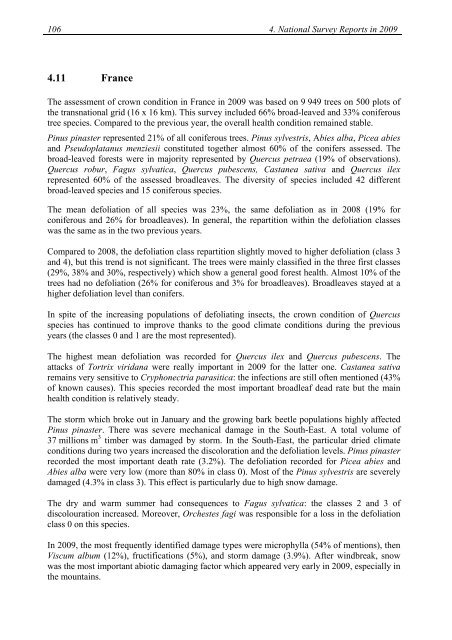Report - ICP Forests
Report - ICP Forests
Report - ICP Forests
You also want an ePaper? Increase the reach of your titles
YUMPU automatically turns print PDFs into web optimized ePapers that Google loves.
106 4. National Survey <strong>Report</strong>s in 2009<br />
4.11 France<br />
The assessment of crown condition in France in 2009 was based on 9 949 trees on 500 plots of<br />
the transnational grid (16 x 16 km). This survey included 66% broad-leaved and 33% coniferous<br />
tree species. Compared to the previous year, the overall health condition remained stable.<br />
Pinus pinaster represented 21% of all coniferous trees. Pinus sylvestris, Abies alba, Picea abies<br />
and Pseudoplatanus menziesii constituted together almost 60% of the conifers assessed. The<br />
broad-leaved forests were in majority represented by Quercus petraea (19% of observations).<br />
Quercus robur, Fagus sylvatica, Quercus pubescens, Castanea sativa and Quercus ilex<br />
represented 60% of the assessed broadleaves. The diversity of species included 42 different<br />
broad-leaved species and 15 coniferous species.<br />
The mean defoliation of all species was 23%, the same defoliation as in 2008 (19% for<br />
coniferous and 26% for broadleaves). In general, the repartition within the defoliation classes<br />
was the same as in the two previous years.<br />
Compared to 2008, the defoliation class repartition slightly moved to higher defoliation (class 3<br />
and 4), but this trend is not significant. The trees were mainly classified in the three first classes<br />
(29%, 38% and 30%, respectively) which show a general good forest health. Almost 10% of the<br />
trees had no defoliation (26% for coniferous and 3% for broadleaves). Broadleaves stayed at a<br />
higher defoliation level than conifers.<br />
In spite of the increasing populations of defoliating insects, the crown condition of Quercus<br />
species has continued to improve thanks to the good climate conditions during the previous<br />
years (the classes 0 and 1 are the most represented).<br />
The highest mean defoliation was recorded for Quercus ilex and Quercus pubescens. The<br />
attacks of Tortrix viridana were really important in 2009 for the latter one. Castanea sativa<br />
remains very sensitive to Cryphonectria parasitica: the infections are still often mentioned (43%<br />
of known causes). This species recorded the most important broadleaf dead rate but the main<br />
health condition is relatively steady.<br />
The storm which broke out in January and the growing bark beetle populations highly affected<br />
Pinus pinaster. There was severe mechanical damage in the South-East. A total volume of<br />
37 millions m 3 timber was damaged by storm. In the South-East, the particular dried climate<br />
conditions during two years increased the discoloration and the defoliation levels. Pinus pinaster<br />
recorded the most important death rate (3.2%). The defoliation recorded for Picea abies and<br />
Abies alba were very low (more than 80% in class 0). Most of the Pinus sylvestris are severely<br />
damaged (4.3% in class 3). This effect is particularly due to high snow damage.<br />
The dry and warm summer had consequences to Fagus sylvatica: the classes 2 and 3 of<br />
discolouration increased. Moreover, Orchestes fagi was responsible for a loss in the defoliation<br />
class 0 on this species.<br />
In 2009, the most frequently identified damage types were microphylla (54% of mentions), then<br />
Viscum album (12%), fructifications (5%), and storm damage (3.9%). After windbreak, snow<br />
was the most important abiotic damaging factor which appeared very early in 2009, especially in<br />
the mountains.
















